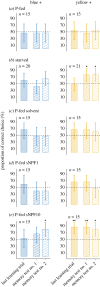The short neuropeptide F (sNPF) promotes the formation of appetitive visual memories in honey bees
- PMID: 35104428
- PMCID: PMC8807059
- DOI: 10.1098/rsbl.2021.0520
The short neuropeptide F (sNPF) promotes the formation of appetitive visual memories in honey bees
Abstract
Motivation can critically influence learning and memory. Multiple neural mechanisms regulate motivational states, among which signalling via specific neuropeptides, such as NPY in vertebrates and NPF and its short variant sNPF in invertebrates, plays an essential role. The honey bee (Apis mellifera) is a privileged model for the study of appetitive learning and memory. Bees learn and memorize sensory cues associated with nectar reward while foraging, and their learning is affected by their feeding state. However, the neural underpinnings of their motivational states remain poorly known. Here we focused on the short neuropeptide F (sNPF) and studied if it modulates the acquisition and formation of colour memories. Artificially increasing sNPF levels in partially fed foragers with a reduced motivation to learn colours resulted in significant colour learning and memory above the levels exhibited by starved foragers. Our results thus identify sNPF as a critical component of motivational processes involved in foraging and in the cognitive processes associated with this activity in honey bees.
Keywords: appetitive motivation; honey bees; learning; memory; short neuropeptide F (sNPF).
Figures


References
-
- Tarpy RM, Bourne LE. 1982. Principles of animal learning and motivation. Upper Saddle River, NJ: Scott Foresman/Addison-Wesley.
Publication types
MeSH terms
Substances
LinkOut - more resources
Full Text Sources
Medical
Miscellaneous

